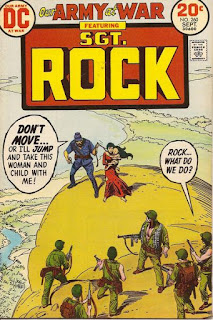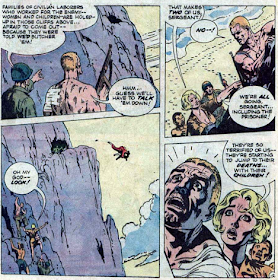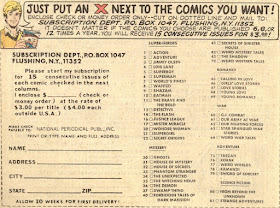The EC Reign Month by Month 1950-1956
69: October 1955 Part II
 |
| Evans |
"The Green Kids" ★★1/2
Story by Jack Oleck?
Art by George Evans
"The Good Luck Piece" ★★★
Story by Carl Wessler
Art by Bernie Krigstein
"The Novice and the Ace" ★★★
Story by Carl Wessler
Art by Wally Wood
"Home Again" ★★1/2
Story by Carl Wessler
Art by Jack Davis
Major Joseph Caswell is sick to death of watching as "The Green Kids," new pilots assigned to his squad, are shot down day in and day out. The academy gives the kids five hours of training and then spits them out for fighting. Pleas (and later insults) to his CO help not one bit and Caswell must change his style of fighting to protect those youngsters around him and salvage the squad. When Colonel Ross is reassigned, Caswell welcomes the chance to change the way things are done from the top down but he quickly discovers that he's just another cog in the wheel like his predecessor. Weeks later, Ross makes a return visit and Caswell, now apologetic and understanding, stands in shock as Ross introduces his traveling companions: three captured German pilots who had a mere three hours of training! "The Green Kids" is a strange one, almost as though it's unfinished. It's got a clear climax, to be sure, but it almost feels like one that's leading to a page eight that never comes. To be sure, George Evans's work is dynamite, an absolute joy to look at, with elaborate detail (check out the little notations on Caswell's wing on the splash) and characters that seem to live and breathe.
 |
| "The Good Luck Piece" |
The boys head out and, on the way, Pete asks Buddy where Hap is hiding and, when Buddy tells him, Pete insists he go back in for the good luck charm. No way are they flying without it. When Buddy tells him he's going up regardless, Pete gives him a killer right and lays his friend out. When he comes to, the squadron is already in the air but Buddy manages to catch up quickly. Pete's plane is ambushed and he's killed but Buddy avenges him, sending Pete's killers to hell in little pieces. Buddy lands and muses that he'll never believe in good luck charms again as it surely didn't do his best friend any good, until he looks down and sees Pete's blue garter wrapped around his hand. A twist climax like the one presented in "The Good Luck Piece" runs the risk of being maudlin but the final reveal is a poignant one. Wessler creates two genuinely likable characters who seem intelligent but hang their chances of survival on inanimate objects. Bernie Krigstein comes through, avoiding the cartoony style that creeps in from time to time (his Red Cross volunteer is a real sweetheart), although I will say those panels are starting to get really crowded with Fokkers and Spads.
 |
| More Krigstein! |
The aces of Squadron 9 like to think they're burly he-men but something new has them heading back to base just as soon as they can. That something is the German Pfalz, decorated with 26 kills. Our boys are aces, but with only five kills apiece, they're barely aces and this new threat scares the bejesus out of them. Along comes the new kid, Pierce, who claims that within a week he'll have more "kills" than all the men combined. No amount of bullying takes this boy off his grandstand and so, the next day, the rest of the men head up into the clouds to see what this kid can do. It's a pretty easy day until the Pfalz arrives and Pierce decides to take him on. The other boys, knowing all too well that Pierce will probably end up as emblem #27, head back to the base.
 |
| "The Novice and the Ace" |
 |
| "Home Again" |
Jack- Evans's plane work in "The Green Kids" is superb and the story is well-told and compassionate but holds no surprises. I'm not as fond of Krigstein as you are, Peter, so I thought the art in "The Good Luck Piece" was uneven, though the tale held some excitement. The unexpectedly light tone of "The Novice and the Ace" was a relief, as you point out, and Wood is his usual stalwart self. As for "Home Again," it was told well enough to overcome my initial difficulty with taking it at all seriously in the face of the Jack Davis art.
 |
| Craig |
"Dateline: New York City"★★★1/2
Story and Art by Johnny Craig
"Steve Rampart"★★★
Story Uncredited
Art by John Severin
"Geri Hamilton"★★★
Story Uncredited
Art by Reed Crandall
"Dateline: Rio Para"★★1/2
Story and Art by Johnny Craig
Keith Michaels accidentally bumps into a bank robber as the man is escaping with his loot across a city sidewalk. The bandit's mask slips as he takes a shot at Michaels, who gets a glimpse of his face. Michaels is brought down to the station, where he pores over mug shots and identifies the crook as Eddie Broder; Keith turns down the offer of a bodyguard, even though he is the only man who can identify the bank robber.
 |
| "Dateline: New York City" |
It's no secret that I love Johnny Craig's work, and I thoroughly enjoyed "Dateline: New York City." I'll admit that it's a bit silly to have Broder following Michaels all over the Big Apple taking pot shots at him, but Craig's style of storytelling is so cheerful and breezy that I am always happy to take the ride. His characters and situations are a bit old-fashioned, but what fun!
 |
| "Steve Rampart" |
Simple and straightforward, with sharp art by John Severin, this Steve Rampart tale is another satisfying read. I did not think for a moment that Steve was dead but I wasn't sure how he got out of that tight spot. Like Craig's Keith Michaels in the first story, Steve has an eye for the ladies, allowing the artist free rein to populate the panels with pretty girls.
 |
| "Geri Hamilton" |
Soon enough, they find the other man, who also says he's not Dannon. The horse runs off and the three spend the next two days marching trough the woods with Geri unable to sleep for fear that the criminal will take her gun. Eventually, she falls asleep; the bank robber beats up the FBI agent and holds him and Geri at gunpoint. She reveals her strategy when she tells him that she removed the bullets from her gun, assuming that the crook would make a play for it. The agent overpowers the bad guy and Geri admits that she lied about the gun--the bullets were in it all along. At least now she can get some sleep!
I love Reed Crandall's work and, while the first two stories in this issue focused on men who loved women, this time the perspective is switched and a woman is the heroine. Not surprisingly, she does not go around ogling the beefcake! The story is another fun, tense one, with another reporter going well beyond the usual typewriter and copy room and encountering unexpected danger.
 |
| "Dateline: Rio Para" |
"Dateline: Rio Para" has the usual elements needed to make a good story, including strong art by Craig and a confrontation between the reporter and a man who seems guilty, but it's a bit abbreviated at six pages and seems to rush to a conclusion. Girl reporter Ruth Hastings is just window dressing.-Jack
Peter: "New York City" has more great, manly Craig art but the script is a whole lot of blah. The real story is why the other reporters treat this like a big story. This is New York City, not Akron; surely, there's something more important happening in Manhattan? The rest of the issue follows suit: great art, ho-hum and unbelievable scripts. This is supposed to be an exciting and suspenseful funny book, correct? The only suspense I had reading this book was wondering why Geri Hamilton didn't just kiss the two men and find out which one was the bad guy.
 |
| Wood |
"Gratitude"★★
Story Uncredited
Art by Joe Orlando
"The Know-Nothing"★★★1/2
Story Uncredited
Art by Bernie Krigstein
"The Taste of Freedom"★★
Story Uncredited
Art by Graham Ingels
"A Knight's Dream"★★★1/2
Story Uncredited
Art by Reed Crandall
Aging, bent over, and half blind, former Roman Centurion Marcus Hostus picks up scraps of food in alleys and thinks back to his younger days when he was a hero in battle, leading soldiers as they beat back rebellious slaves near the Via Appinilli. Once, he met an old man and his grandson and became greedy for their treasure to the point of letting them be killed by rebels. He buried the treasure and from then on fought for his hidden wealth, not for the glory of Rome. He even turned down an annual stipend from the government when it was offered to him. One day, a soldier finds him and tells him that the government has decided to give him the stipend he turned down long ago. He is shown a statue of himself and, to his dismay, he learns that they dug beneath it and found his long-hidden treasure, which will now go into the coffers of the empire!
 |
| "Gratitude" |
We complain about Joe Orlando's art for EC, especially in its later years, but his style seems right for "Gratitude," a reasonably interesting story with a twist ending that is not much of a shock. The only thing that puzzled me was why Marcus waited so long to reap the fruits of his hidden treasure. Why not dig up a bauble now and then and avoid scavenging through the alleys for food?
One night in 1745, Englishman John Venner enters the cottage of old Brian Macnice and announces that he is taking the old man at gunpoint and using him as a guide to travel to Stirling Castle to kill Bonnie Prince Charlie in order to prevent the prince from pursuing his quest to take Scotland back from England. Venner and Macnice travel for days and nights across the Scottish countryside, with Venner passing the time by asking Macnice questions about Scottish history, questions that elicit nary a single correct answer from "The Know-Nothing." They reach the River Forth and take a ferry across, but Macnice informs Venner that he pulled the stopcock and the ferry is sinking, along with Venner's cart full of gunpowder that was supposed to blow up the castle. Venner can't swim and Macnice has the last laugh as he heads for shore.
 |
| "The Know-Nothing" |
Krigstein outdoes himself in this charming mix of history lesson and character study, and the journey across the Scottish countryside is beautifully rendered. This is one of my favorite EC stories by Krigstein to date.
 |
| "The Taste of Freedom" |
Ghastly's art is rather stodgy and the story is run of the mill, but it's always nice to see the cruel and powerful brought low, as they are in "The Taste of Freedom."
 |
| "A Knight's Dream" |
Ending a superb issue of Valor, Reed Crandall's art on "A Knight's Dream" continues to impress me. I am not sure I buy the story of Saladin's treachery, since it doesn't square with what I've read of Saladin, but the story is a stirring one. I'm sorry there is just one issue to go in this excellent series.-Jack
Peter: With its fourth issue, Valor remains neck and neck with Piracy for Best New Direction title, thanks to four very solid dramas, the strongest of which has to be "The Know-Nothing." The story almost reads like one of those lengthy story-jokes that make you laugh out loud and think at the same time. I actually chuckled several times as Venner escalated his insults about the old Scot (dolt, dumbbell, blockhead, etc.) and never saw the twist coming. A delight from start to finish, as was the rest of the issue. Not that it's just suddenly struck me, but I'm not sure I've mentioned how impressed I am that the average EC comic book takes at least twice as long to read as any of the books by the other publishers we read on our various blogs. Each story is dense with words (yes, I know we've mentioned that it's not always a good trait, but . . .), a sign that the EC writers really cared for their craft.
 |
| "The Know-Nothing" |
 |
| Next Week in Star Spangled #142 . . . Sink your teeth into a bloody Weird War Tale! |




































